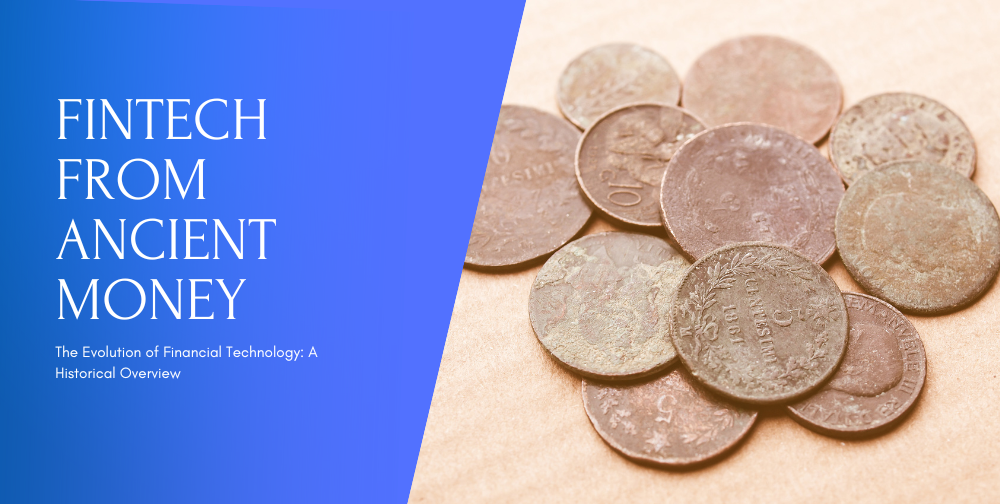The Evolution of Financial Technology: A Historical Overview

Financial technology, often referred to as fintech, encompasses the innovative application of technology to improve financial services. This evolution traces back to ancient times, transforming significantly through various historical epochs to become the complex and sophisticated system we know today. This article provides a detailed examination of the history of financial technology, exploring its progression from ancient civilizations to the modern digital age.
Ancient Civilizations: Bartering and Trading
In the earliest human societies, bartering was the primary method of exchanging goods and services. People traded items of intrinsic value, such as livestock, grains, and handcrafted goods, to fulfill their needs. This system was prevalent in many ancient civilizations, including Mesopotamia, Egypt, and the Indus Valley.
Bartering, while effective in small communities, had limitations. The lack of a standardized medium of exchange made transactions cumbersome and often inequitable. This challenge led to the creation of more structured financial systems.
The Introduction of Money
The invention of money was a pivotal moment in financial history. Around 600 BCE, the Lydians, an ancient civilization in what is now Turkey, are credited with creating the first standardized coins. These coins were made of electrum, a natural alloy of gold and silver, and marked with official insignia to guarantee their value.
The introduction of money facilitated trade by providing a common medium of exchange, thereby simplifying transactions and fostering economic growth. This innovation quickly spread across different civilizations, including Greece, Rome, and China, each developing their own coinage systems.
Medieval Europe: The Birth of Banking
During the Medieval period, Europe saw the emergence of more sophisticated financial systems. The development of banking can be traced back to this era, with the first known banks established in Italy. The Medici family, for example, founded the Medici Bank in the 14th century, which became one of the most powerful financial institutions of the time.
Medieval banks provided a range of services that laid the groundwork for modern banking. They offered loans, facilitated currency exchange, and provided safekeeping for money and valuables. The use of bills of exchange allowed merchants to conduct business across long distances without the need to carry large sums of money, reducing the risk of theft.
The Industrial Revolution: Technological Advancements
The Industrial Revolution of the 18th and 19th centuries brought about significant technological advancements that transformed financial systems. Innovations in communication and transportation, such as the telegraph and the railway, enabled faster and more efficient transactions.
The establishment of central banks, such as the Bank of England in 1694, also played a crucial role in stabilizing financial systems and regulating the money supply. These institutions introduced banknotes, which provided a more convenient and secure means of payment compared to coins.
The 20th Century: Credit Cards, ATMs, and Electronic Payments
The 20th century marked a period of rapid innovation in financial technology. The introduction of credit cards revolutionized the way people made purchases. The first universal credit card, issued by Diners Club in 1950, allowed consumers to make purchases at various merchants without carrying cash.
Automated Teller Machines (ATMs), introduced in the late 1960s, provided 24/7 access to banking services. Customers could withdraw cash, check balances, and perform other transactions without visiting a bank branch. The convenience of ATMs contributed to the widespread adoption of electronic banking.
Electronic payment systems emerged in the latter half of the 20th century, further enhancing transaction efficiency. The creation of the Electronic Fund Transfer (EFT) system enabled the direct transfer of funds between bank accounts, reducing the reliance on paper checks and improving transaction speed and accuracy.
The Birth of the Internet: Online Banking and E-commerce
The advent of the internet in the late 20th century revolutionized the financial industry. Online banking emerged as a convenient way for consumers to manage their finances from home. The first online banking services were offered in the 1990s, allowing customers to check balances, transfer funds, and pay bills via the internet.
E-commerce also flourished with the rise of the internet. Companies like Amazon and eBay transformed retail by enabling consumers to purchase goods and services online. Payment processors such as PayPal provided secure and efficient means of transferring money for online transactions.
The 21st Century: Mobile Technology and Fintech Innovations
The 21st century has witnessed unprecedented advancements in financial technology. Mobile technology, in particular, has had a profound impact on how people conduct financial transactions. Smartphones and mobile apps have made it possible to manage finances, make payments, and transfer money on the go.
Mobile payment systems such as Apple Pay, Google Wallet, and Samsung Pay have gained widespread adoption, allowing users to make purchases with a simple tap of their smartphone. These systems use Near Field Communication (NFC) technology to enable secure and convenient transactions.

Cryptocurrency: A New Era of Digital Currency
Cryptocurrency represents a significant leap in the evolution of financial technology. Bitcoin, introduced in 2009 by an anonymous entity known as Satoshi Nakamoto, was the first decentralized digital currency. Bitcoin operates on a technology called blockchain, a distributed ledger that records all transactions across a network of computers.
Cryptocurrencies offer several advantages, including lower transaction fees, enhanced security, and the potential for financial inclusion. However, they also present challenges, such as regulatory uncertainty and price volatility. Despite these challenges, cryptocurrencies have gained traction, with numerous other digital currencies being developed and adopted globally.
Robo-Advisors and Peer-to-Peer Lending
Financial technology has also expanded to include services such as robo-advisors and peer-to-peer lending platforms. Robo-advisors use algorithms and artificial intelligence to provide automated investment advice and portfolio management. These platforms offer a cost-effective alternative to traditional financial advisors, making investment services more accessible to a broader audience.
Peer-to-peer (P2P) lending platforms connect borrowers with investors, bypassing traditional financial intermediaries such as banks. P2P lending offers borrowers more competitive interest rates and provides investors with opportunities for higher returns. Companies like LendingClub and Prosper have popularized this model, contributing to the diversification of financial services.
The Rise of Artificial Intelligence and Blockchain Technology
In recent years, artificial intelligence (AI) and blockchain technology have emerged as transformative forces in the financial industry. AI is being leveraged to enhance customer service, detect fraud, and improve investment strategies. Machine learning algorithms analyze vast amounts of data to identify patterns and make predictions, enabling more informed financial decision-making.
Blockchain technology, beyond its application in cryptocurrencies, is being explored for various financial services. Its decentralized and transparent nature makes it suitable for applications such as cross-border payments, supply chain finance, and smart contracts. Blockchain has the potential to reduce costs, increase efficiency, and enhance security in financial transactions.
Conclusion
The evolution of financial technology has been a continuous process, driven by the need for more efficient, secure, and convenient financial services. From the earliest forms of bartering and the introduction of money to the sophisticated digital platforms of today, each advancement has built upon previous innovations to shape the modern financial landscape.
The future of financial technology holds immense potential, with advancements in AI, blockchain, and other emerging technologies set to further transform the industry. As fintech continues to evolve, it will undoubtedly play a crucial role in shaping how we manage our finances and conduct transactions in the years to come.





